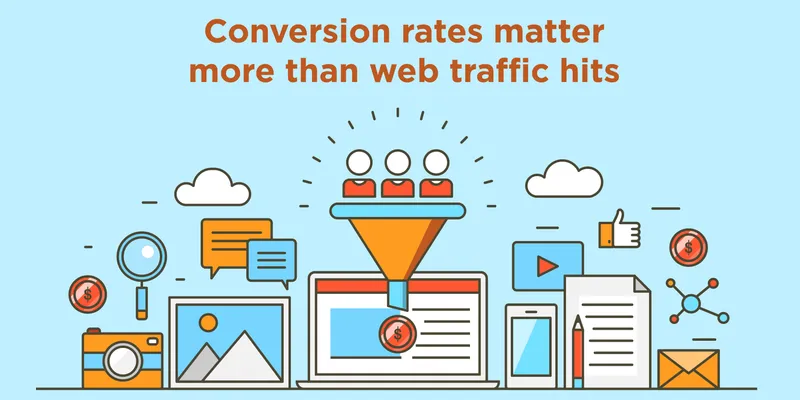Conversion rates matter more than web traffic hits — how to craft a winning Conversion Rate Optimisation strategy
To quote a piece of wisdom apt for our digital age, “a single accurate measurement is worth more than a thousand expert opinions.” This statement might as well have been developed keeping in mind the internet and the ability it gives website owners to measure all types of user interaction down to the tee. The approaches to understanding the volumes of data created online can very easily leave you confused as to which ones to concentrate on.

Image credit: Shutterstock
Therefore, it is very important that you decide, smartly, beforehand on what metrics you need to take advantage of when you are thinking of embarking on SEO or email marketing. By pinpointing the metrics that are of value to you, you can then comprehend which tools are necessary to collect and analyse the required data. Through adequate study of this data, you can glean actionable intelligence that will give you a competitive edge in your operations.
Conversions vs web hits
Therefore, without much ado, let us dive in and define these two interrelated terms, conversion and website traffic hits. Conversion refers to the deliberate action of converting website visitors into paying customers. The efficacy of conversion marketing is measured by the conversion rate. Conversion Rate Optimisation (CRO) is a system for increasing the percentage of visitors to a website that convert to customers, which is the standard definition according to the ever useful Wikipedia. The extended definition includes increasing the percentage of visitors completing a desired action, such as signing up for newsletters and similar desired outcomes. Website traffic hits on the other hand refers to the amount of data sent and received to a website by visitors. It is determined by the number of visitors to the website and the number of web pages that they visit. Most websites have some type of software whose sole purpose is to measure this type of data, including pages visited, the time of visits, countries and cities of origin, devices used to access the website, operating systems of the devices and much, much more, all in real-time.
Hire the experts
It is now increasingly clear that the true metric for a website owner is not necessarily the total number of hits the website gets, but the specific hits that led to conversions. The point is to ensure that the visits lead to conversions. We must keep in mind that 70 percent of website visitors will bounce, i.e. interact with your website for less than 30 seconds and leave.
Now that we have made a clear distinction between CRO and website traffic, let us get down to giving you a brief guide on how you can execute a winning CRO strategy;
- Gather data: An effective CRO strategy will have to be based on the raw information mentioned earlier, such as the number of users on your site, the pages they visit and whether they complete the intended action.
Therefore, it is incumbent upon you to have a solid data gathering plan in effect, as this data will yield information to you that will aid in the making of evidence-based actionable decisions.
- Data mining: The first step, as described above, is gathering the raw material, the data. Second, you need to know what to do with it in order for you to get actionable conversion insights. This is data mining, the process through which you learn to evaluate the data collected to glean useful information.
- A/B testing: This is also known as split testing; it involves comparing two versions of a web page in order to see which one performs better. This is achieved by showing two variants of a web page (say A and B) to similar visitors, simultaneously.
The one that provides a better conversion rate wins. Therefore, you will need to set up such a test in order for you to come up with a winning variation that will lead to a higher conversion rate. That is the whole purpose of this test.
- Funnel optimisation: The conversion funnel refers to the journey that a consumer takes through an internet advertising system. It starts with navigating the website and ends with the conversion to a sale.
This term refers to the decrease in steps necessary for you to reach the goal. In effect, this is but a subset of funnel analysis, which uses a series of predefined events that are designed to lead towards a defined goal. You must incorporate this in your strategy if you are to have a chance at success.
- Measuring conversion efforts: You will need a system to measure the efficacy your CRO efforts. That is, a sound statistical framework that you will use in order to ascertain the percentage of visitors making purchases for the whole exercise to be considered a success.
The industry standard for a successful Conversion Rate Optimisation (CRO) programme is six to nine percent. That is the benchmark figure, and so you should strive to go way beyond this in your programme in order to increase your gross sales and ultimately your bottom-line.
Therefore, it is evident that you should not just focus on the total number of hits on your website and use that for bragging rights, since those hits have no meaning for your business without being coupled with impressive CRO rates.
I hope this article has convinced you of the need to shift focus to conversion rates as the primary metric to be considered when assessing the effectiveness of your web strategy. Please share your thoughts in the comments section below.
(Disclaimer: The views and opinions expressed in this article are those of the author and do not necessarily reflect the views of YourStory.)







